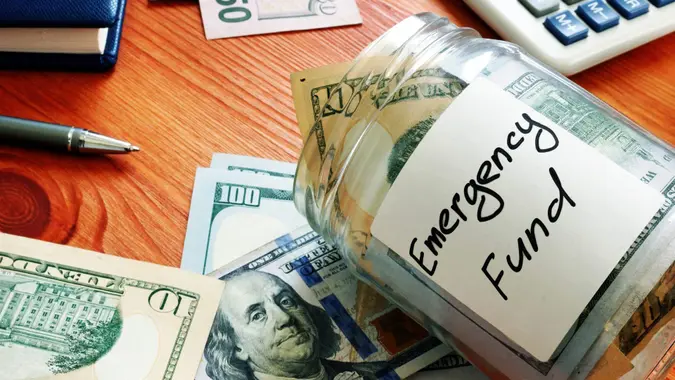Advertiser Disclosure
GOBankingRates works with many financial advertisers to showcase their products and services to our audiences. These brands compensate us to advertise their products in ads across our site. This compensation may impact how and where products appear on this site. We are not a comparison-tool and these offers do not represent all available deposit, investment, loan or credit products.
Cutting Expenses To Pay Off Debt? Experts Say To Cut This First
 Written by
Cynthia Measom
Written by
Cynthia Measom
 Edited by
Carly Brashears
Edited by
Carly Brashears

Commitment to Our Readers
GOBankingRates' editorial team is committed to bringing you unbiased reviews and information. We use data-driven methodologies to evaluate financial products and services - our reviews and ratings are not influenced by advertisers. You can read more about our editorial guidelines and our products and services review methodology.

20 YearsHelping You Live Richer

Reviewed by Experts

Trusted by Millions of Readers
When money’s tight and you’re swimming in debt, bringing in additional income through extended work hours or a weekend side hustle isn’t always an option.
If that’s the case, cutting some of the discretionary expenses you have — those that are nonessential — is often the best route to reduce your debt.
But where should you start? According to different experts, here are examples of the one thing you should cut first from your expenses.
Drive-Thru Purchases
“The easiest place to start that typically has the highest return are food and drink consumables,” said Joe Minnitte from Proof Principles Matter and the podcast Your Money Explained. “This would be grabbing a coffee on the way to work or a burger on your way home.
“On average, people spend $2,100 per year on coffee and approximately $3,000 per year eating out. If you stopped just these two, you could reallocate that $5,100 savings towards paying down debt. That would be life-changing progress just for changing your habits without giving up weekends to work a second job.”
Minnitte added that the amounts you actually spend on these types of purchases may be different from what he quoted — but he believes it’s likely you are spending more than you think.
Unnecessary Subscriptions
Loretta Kilday, Esq., senior attorney and spokesperson for Debt Consolidation Care, suggested getting rid of unnecessary subscriptions that you aren’t using as a way to cut expenses.
“This may include unused streaming services, magazine subscriptions that you rarely read and seldomly used gym memberships among others,” she said. “You can save money immediately in this space without drastically affecting your daily life because of its simplicity.”
Kilday said that many people don’t realize how much money they spend each month on subscriptions until they sit down and calculate them all.
“The possible savings can add up significantly in relation to cutting unnecessary subscriptions,” she said. “It is common for people to sign up with several streaming services at a cost ranging between $10-$15 each month. By canceling only three of these, one might be able to save around $30-$45 each month. This is a simple area to cut back on, and that money saved can go straight towards reducing debt.”
Entertainment
David Bakke, personal finance expert at DollarSanity said, “To help pay off debt, the first expense you should cut is entertainment because you shouldn’t be living it up when you’re in over your head financially. However, you shouldn’t eliminate it entirely or you’re likely to give up the strategy of getting out of debt.”
How much you should cut depends on how much you spend. Bakke gave an example of someone who spends $400 a month (or $100 per week) on entertainment and said to cut weekly expenses to $75. By doing this you’ll save $100 per month that you can put toward debt.
You can also be more aggressive and cut weekly expenses in half, to $50, which would save you $200 per month.
Your Extra Vehicle
“If you’re part of a dual-income household where one or both of you work from home, consider going down to one car,” suggested Bri Conn, investment advisor representative of Childfree Wealth, a life and financial planning firm dedicated to helping childfree and permanently childless people. “My spouse and I have been using one car since late 2021. I work from home and my spouse is often on the road.
“In June 2022, I sold my paid off vehicle and we’ve been operating on one vehicle since. In that time we’ve estimated it has saved us at least $5,000 simply from insurance, maintenance and gas alone. This could easily be even more had I still had a loan on it and if I lived in a bigger city where I needed to pay for parking.”
Conn said there’s only been a couple of instances where she and her spouse needed to use a rideshare since they downsized their vehicles, and the expenses cost $110 in total. “While it does take some extra planning, it’s well worth the savings,” she said.
Dining Out
“The easiest lifestyle element to modify is dining out,” said Michael Sullivan, a personal financial consultant with Take Charge America. “When in debt, dining out should be eliminated completely. A family of four eating out once a week likely spends over $200 a month and could pay off $150 in debt a month by eating at home.”
Share This Article:




You May Also Like





Dave Ramsey and 2 More Experts Discuss Where They Draw the Line on Tipping
December 02, 2025
5 min Read

I'm a Budgeting Expert: How I Save Big on Phone Plans, Even With an iPhone
December 01, 2025
5 min Read

How the Chinese '4-Column Method' Can Help You Save Your First $10K, According to Humphrey Yang
November 30, 2025
5 min Read


Ramit Sethi Shares 3 Simple Steps To Quickly Build a $1,000 Emergency Fund
November 26, 2025
5 min Read

Frugal Living Expert Kate Kaden's 6 Practical Tips for Living Below Your Means
November 28, 2025
5 min Read


I Asked ChatGPT How Much I Would Have Now If I'd Saved $100 a Month Since 2020
November 25, 2025
5 min Read




5 Things That Could Save You Money This Week, According to a Money Expert
November 24, 2025
5 min Read
Make your money work for you
Get the latest news on investing, money, and more with our free newsletter.
By subscribing, you agree to our Terms of Use and Privacy Policy. Unsubscribe at any time.


Thanks!
You're now subscribed to our newsletter.
Check your inbox for more details.



Sending you timely financial stories that you can bank on.
Sign up for our daily newsletter for the latest financial news and trending topics.
For our full Privacy Policy, click here.
Looks like you're using an adblocker
Please disable your adblocker to enjoy the optimal web experience and access the quality content you appreciate from GOBankingRates.
- AdBlock / uBlock / Brave
- Click the ad blocker extension icon to the right of the address bar
- Disable on this site
- Refresh the page
- Firefox / Edge / DuckDuckGo
- Click on the icon to the left of the address bar
- Disable Tracking Protection
- Refresh the page
- Ghostery
- Click the blue ghost icon to the right of the address bar
- Disable Ad-Blocking, Anti-Tracking, and Never-Consent
- Refresh the page


